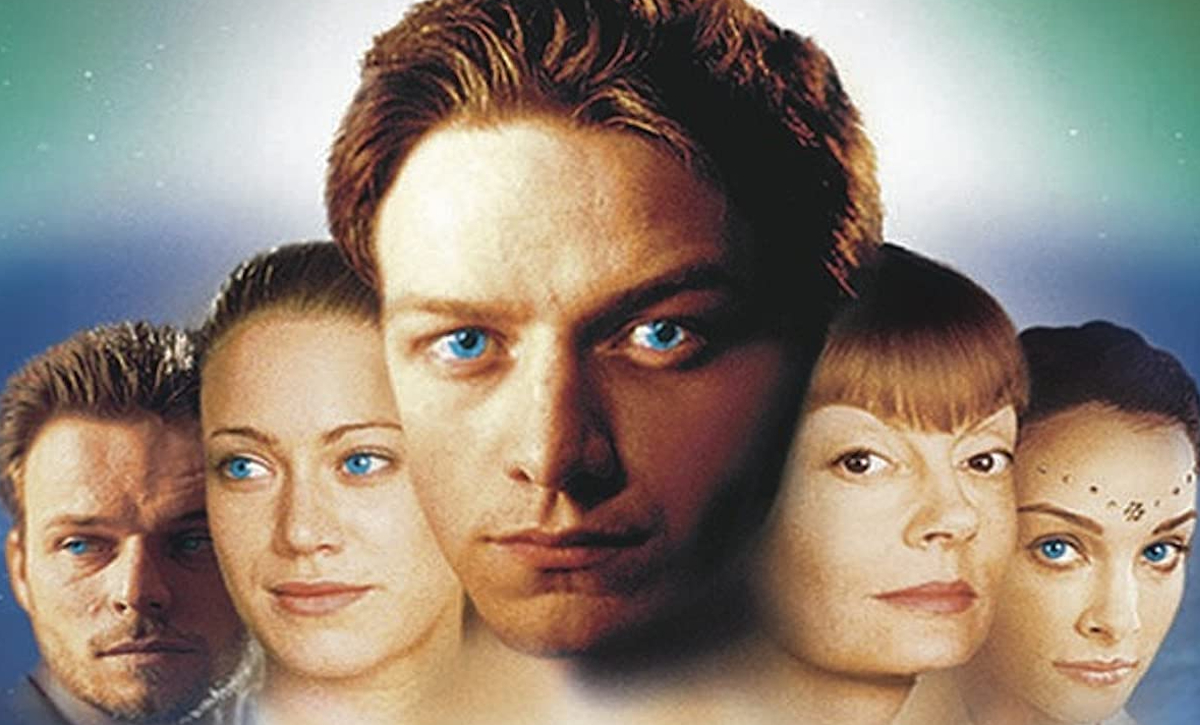
This Dune article contains spoilers.
If the shocking ending of Dune: Part Two left you wanting more, you can actually watch Dune: Part Three right now. Kind of. Although Denis Villeneuve hasn’t fully committed to a movie adaptation of Dune Messiah, there is an often overlooked filmed version of this Dune sequel out there right now. This isn’t a bootleg or a fan film either, but The Sci-Fi Channel’s excellent Frank Herbert’s Children of Dune miniseries. This very real adaptation of Dune Messiah even stars several major Hollywood stars, including James McAvoy and Susan Sarandon, as well as Star Trek legend Alice “The Borg Queen” Krige.
If you’ve slept on this particular Dune sequel, now is possibly the best time to watch it. Here’s what to know about Frank Herbert’s Children of Dune, why it’s great, and how to watch it.
What is Frank Herbert’s Children of Dune?
On March 16, 2003, six months before the debut of the reboot Battlestar Galactica, the Sci-Fi Channel (yes, this was before it changed to “SyFy”) dropped a killer miniseries called Frank Herbert’s Children of Dune. But don’t let the title fool you. Because this three-part miniseries actually adapted two of Herbert’s books, Dune Messiah and Children of Dune, over the course of three episodes. Each part is about 90 minutes long, and the first episode, “Messiah,” adapts the totality of Dune Messiah, fairly faithfully. It also features the return of (most) of the cast from the 2000 smash-hit miniseries Frank Herbert’s Dune.
In fact, in the year 2000, the miniseries version of Dune, written and directed by John Harrison, was the most successful Sci-Fi Channel original at that point. It starred Alec Newman as Paul Atreides, Julie Cox as Irulan, Saskia Reeves as Lady Jessica, Barbora Kodetová as Chani, William Hurt as Duke Leto, and Ian McNeice (Doctor Who’s future Churchill!) as Baron Harkonnen. To date, it remains, without a doubt the most faithful adaption of the first Dune novel, which includes two pivotal plot points both David Lynch and Denis Villeneuve left out of their films: the banquet scene toward the start of the book, and the death of Chani and Paul’s first child, Leto II the Elder. (In the other Dune adaptations, this baby doesn’t even exist!)
After the 2000 Dune was a hit for Sci-Fi, the 2003 sequel, Children of Dune, brought back most of the same creative team, including a screenplay from John Harrison, who, due to scheduling conflicts, was unable to direct, meaning Greg Yaitanes stepped in. Saskia Reeves was unable to reprise her role as Lady Jessica, which is why Alice Krige took over the role. In the context of Krige’s sci-fi cred at the time, this was just two years after she returned as the Borg Queen for the Star Trek: Voyager finale, “Endgame,” in 2001, and 10 years before she appeared in Thor: The Dark World as Eir. While Reeves was a great Jessica, people who love both Trek and Dune will probably agree that Alice Krige really made the role her own in Children of Dune, which, arguably, because it adapts two books, focuses on Jessica even more than the first novel.
Children of Dune also cast a pre-fame James McAvoy as Leto II, alongside Jessica Brooks as his twin sister, Ghanima Atreides. This miniseries also marked the first time an adult played an older version of Alia, in which Daniela Amavia took over the role from Laura Burton, who played the child Alia in the 2000 Dune. Today, Anya Taylor-Joy’s extremely brief cameo as Alia in Dune: Part Two, marks the first cinematic adult version of the character, but Amavia certainly did more with Alia than anyone else has been able to do, ever.
Meanwhile, Susan Sarandon serves as the big bad for the entire series, playing Princess Wensicia, one of Irulan’s sisters, who is eager to reclaim the throne for her family. In a slight change from the books, the Children of Dune miniseries insinuates Wensicia into the events of Dune Messiah, even though she doesn’t show up until the third book. That said, this change is minor compared to some of the liberties that the other major versions of Dune have taken with the story.
Why Frank Herbert’s Children of Dune Is a Different Kind of Dune Adaptation
If you’re looking to scratch that Dune 3 itch, the 2003 Children of Dune miniseries is a must-watch for several reasons. Again, because the first part adapts the entity of Messiah in roughly 90 minutes, basically anything you’re still curious about from the ending of the new film is resolved in the first episode. Alec Newman’s portrayal of Paul in this Dune Messiah is also even better than his take from the 2000 Dune, mostly because he gets to play Paul as more of an adult, and as a troubled dictator. Of all the on-screen Pauls, Newman has taken Paul’s story much further than anyone else, all the way through Paul’s transformation into “the Preacher” in Children of Dune. From Newman’s point-of-view, he felt that his performance got deeper and better in this miniseries, saying in 2022: “…I really felt the benefit of having played him further and further into the story that we get.”
This is evident on screen too, since Dune Messiah is a much darker story than the first Dune. Newman may not have the boyish charm of Timothée Chalamet, but in this Dune sequel, that’s not really the point. In 2004, just one year later, Newman played the genetically engineered Malik, a precursor to Khan, on Star Trek: Enterprise. But, it’s in Children of Dune where you can see Newman playing with some of that sci-fi villain energy. His take on Paul Atreides is nuanced, frightening, and most of all, unique.
The miniseries also treats Dune Messiah the way many fans see the story: as a bridge to the events of Children of Dune, and eventually, God Emperor of Dune. By the end of Messiah, the series isn’t about Paul at all, and arguably, this miniseries makes that case thanks to the excellent casting of McAvoy. The final episode of Children of Dune, “The Golden Path,” features Leto II’s initial fusing with the sand trout, which will lead him to become an outrageous part-human/part-sandworm hybrid, as featured in the fourth book, God Emperor of Dune.
McAvoy’s performance is particularly good as Leto II because he eerily predicts the exact same approach that Chalamet took toward playing Leto II’s father, Paul. As Leto, McAvoy is both flippant and wise; combining a childlike angsty teen performance with something more ominous. If you want to imagine Anakin Skywalker with a light British accent, played by a young Professor X, that’s basically what McAvoy pulls off in Children of Dune. There’s never been another actor to play the part of Leto II, the one who is fated to become the God Emperor of Dune, but because of the standard that McAvoy set, this will be a tough act to follow, if and when a future movie (or TV) adaptation gets that far.
Although the early 2000s CGI of Children of Dune may make the miniseries look dated, in some ways, its visuals have held up better than the 1984 Dune. Plus, if you’re looking for an abundance of story, and not aesthetics, this Dune sequel is, in many ways, superior to Dune: Part Two. The newest Villeneuve film is very sparse with dialogue, which is probably why the director himself recently half-joked, “I hate dialogue. Dialogue is for theater and television.” But because the 2003 Children of Dune is a made-for-TV experience, there is plenty of dialogue. If Dune fans are longing to hear more from Paul, Chani, Alia, Lady Jessica, and more, this is the Dune you’ve been searching for.
For all these reasons, along with the pure novelty of the series — nobody ever got this far in the saga before or since — Frank Herbert’s Children of Dune is worth your time: Not only does it faithfully adapt the events of the second novel, but it allows the kookiness of the third novel to bask fully in all of its Dune-ish weirdness. For all of its considerable merit, it’s hard to imagine Villeneuve’s take on the Dune books ever getting this bonkers.
How to watch Frank Herbert’s Children of Dune (2003)
The 2003 Children of Dune isn’t streaming officially anywhere right now. Your best bet is an absolutely excellent 2017 Blu-ray release. There’s also a DVD version that bundles the 2000 Dune and the 2003 Children of Dune together. Long live the fighters and long live physical media!
Dune: Part Two is in theaters now.
The post Waiting for Dune 3? 21 Years Ago, James McAvoy Made a Perfect TV Version appeared first on Den of Geek.




